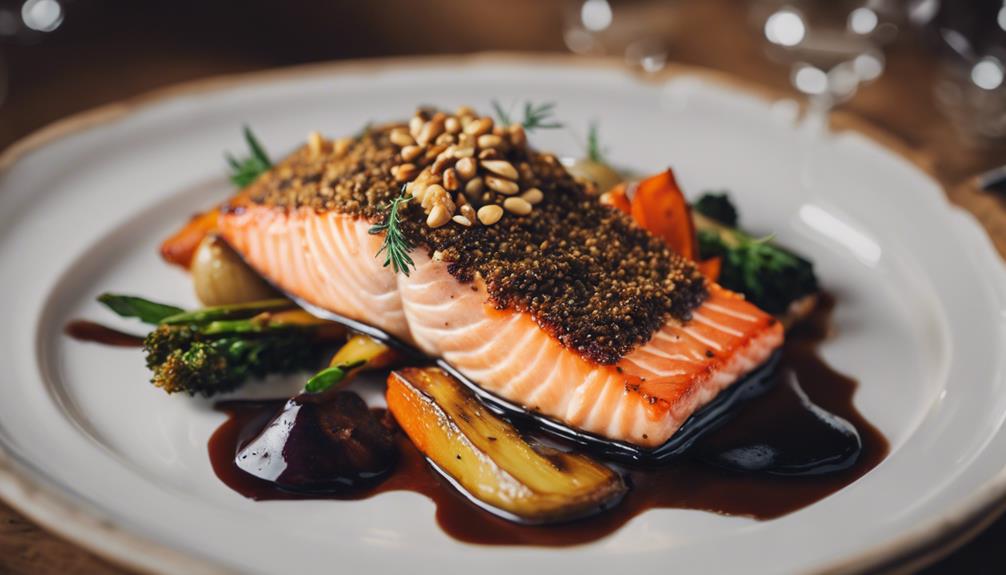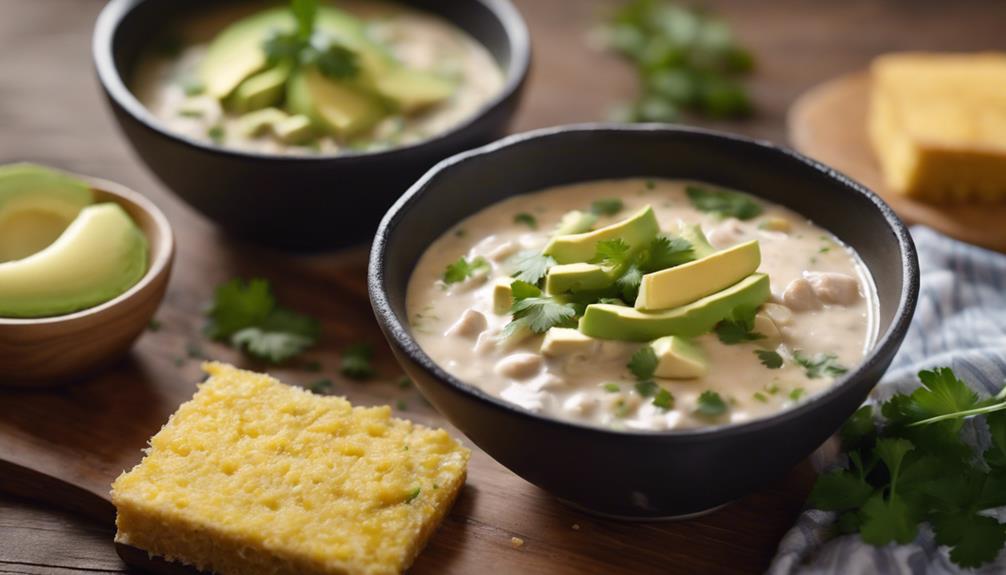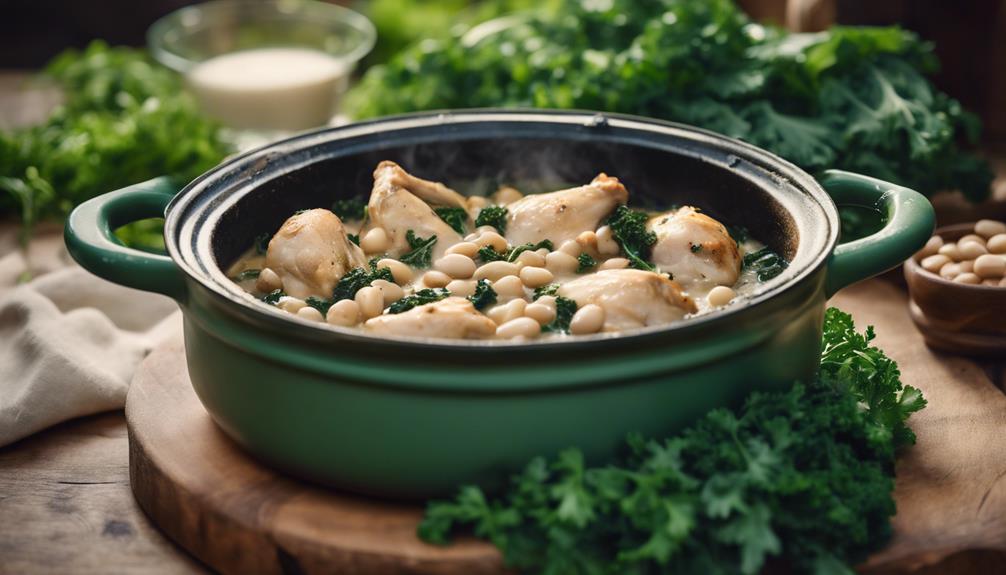Indulge in a culinary treat with Pine Nut Crusted Salmon, a high-quality option that excites your taste buds with a perfect mix of flavors and textures. This gourmet dinner choice showcases fresh salmon fillets coated in crispy pine nuts, breadcrumbs, and flavorful Dijon mustard. The monounsaturated fats and essential nutrients in pine nuts not only enhance the dish’s nutritional profile but also contribute a buttery, slightly sweet flavor. Pair this exceptional dish with sides like quinoa, lemon-dressed arugula, or grilled asparagus for a complete meal. Experience how this salmon dish can elevate your dining experience to a whole new level.
Key Takeaways
- Elevate dinner with a gourmet touch using pine nut-crusted salmon.
- Enjoy heart-healthy fats and nutrients in a flavorful dish.
- Impress guests with a crispy, flavorful crust on tender salmon.
- Pair with wine for a sophisticated dining experience.
- Create a memorable meal with easy-to-follow preparation steps.
Ingredients for Pine Nut Crusted Salmon
To make Pine Nut Crusted Salmon, gather fresh salmon fillets, pine nuts, breadcrumbs, Dijon mustard, and seasonings.
The star of this dish, the salmon, provides a rich source of omega-3 fatty acids, which are beneficial for heart health.
The pine nuts, with their nutty flavor and crunchy texture, elevate the dish by adding a gourmet touch.
Breadcrumbs, when combined with Dijon mustard, create a cohesive crust that perfectly coats the salmon fillets.
The Dijon mustard not only helps bind the crust but also imparts a tangy flavor that complements the richness of the salmon.
Seasonings such as salt, pepper, and herbs enhance the overall taste profile, ensuring a well-balanced flavor experience.
When these ingredients come together, they create a harmonious blend of flavors and textures, making Pine Nut Crusted Salmon a delightful culinary masterpiece that's sure to impress even the most discerning of palates.
Benefits of Cooking With Pine Nuts
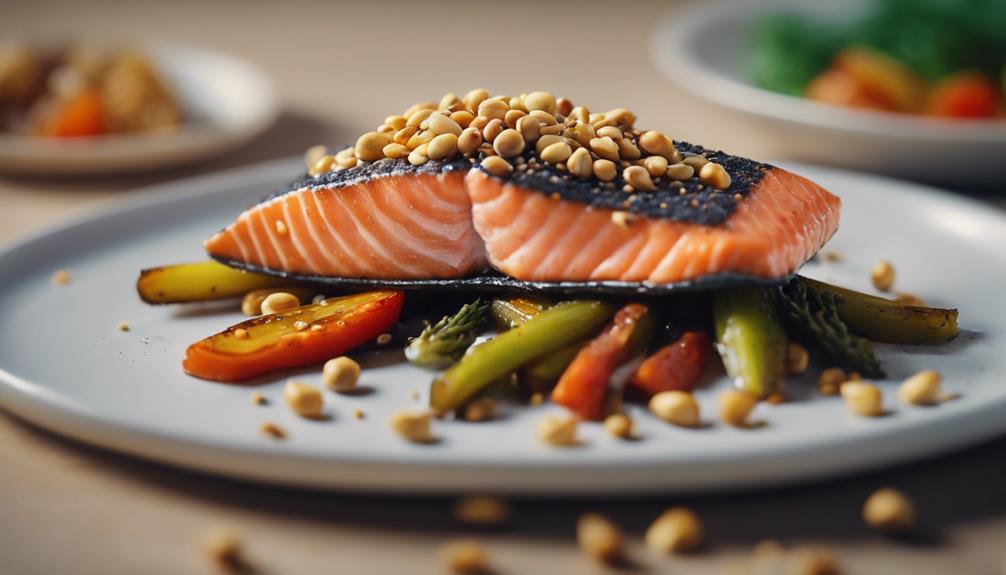
Cooking with pine nuts offers numerous benefits. They're packed with heart-healthy monounsaturated fats, vitamins, and minerals, providing essential nutrients for your body.
Additionally, their buttery flavor enhances dishes, making them a versatile and delicious ingredient to incorporate into your cooking.
Nutritional Value
Boosting your dishes with pine nuts can greatly enhance their nutritional value. Pine nuts are a powerhouse of nutrients, containing heart-healthy monounsaturated fats that support overall health. These nuts are a rich source of magnesium, essential for bone health and muscle function.
Additionally, pine nuts provide vitamin K, essential for blood clotting and bone metabolism. Packed with antioxidants, they help reduce inflammation and protect against chronic diseases. Incorporating pine nuts into your diet can also aid in weight management and appetite control by improving satiety.
Flavor Enhancer
Enhancing your culinary creations with pine nuts can introduce a unique and gourmet flavor profile to your dishes. When using toasted pine nuts in your cooking, you can benefit from:
- Rich Nutrients: Toasted pine nuts are packed with healthy fats, protein, and antioxidants, offering a nutritious boost to your meal.
- Buttery Sweetness: The unique flavor of toasted pine nuts adds a buttery and slightly sweet taste to dishes like salmon, elevating them to a gourmet level.
- Crunchy Texture: Pine nuts are known for their crunchy texture, which can provide a delightful contrast to the tender salmon fillets, enhancing the overall dining experience.
Incorporating toasted pine nuts in recipes like pine nut-crusted salmon not only enhances the taste but also elevates the visual appeal of the dish, making it a sophisticated and upscale choice for special occasions.
Step-by-Step Salmon Preparation
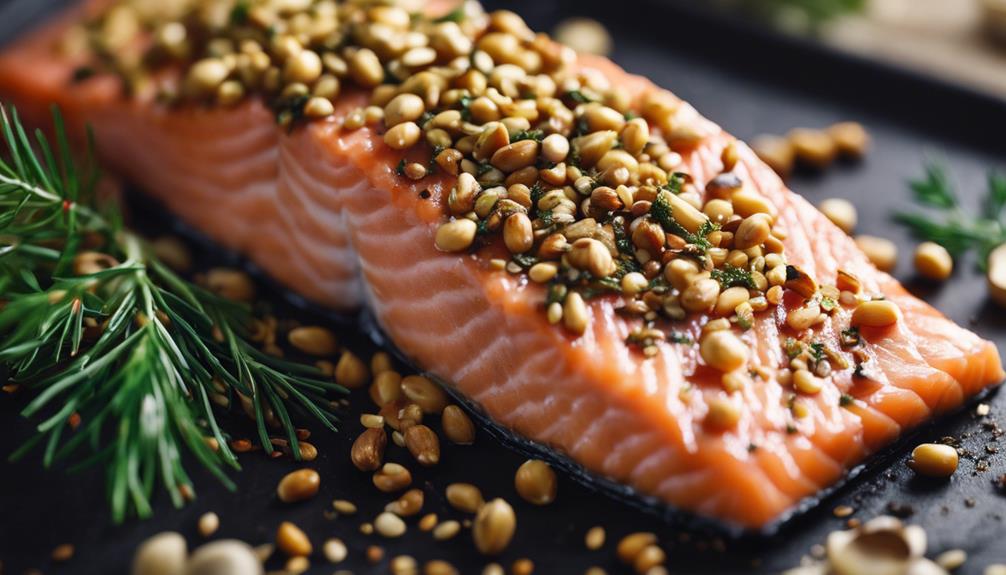
When preparing salmon, selecting fresh fillets is essential for the best flavor.
The nut crust preparation involves brushing the fillets with Dijon mustard before adding the breadcrumb and pine nut mixture.
Follow baking instructions carefully, ensuring the salmon bakes for 8 to 10 minutes in the oven until reaching your desired level of doneness.
Salmon Selection Tips
To guarantee the success of your pine nut crusted salmon dish, start by selecting fresh, high-quality fillets with vibrant color and firm texture.
When choosing salmon for this gourmet dinner option, consider the following tips:
- Look for fillets that have a vibrant color and a shiny appearance, indicating freshness.
- Confirm the texture of the fillets is firm to the touch, which is a sign of good quality.
- Smell the salmon to verify it has a clean, ocean-like scent, indicating freshness and quality.
Nut Crust Preparation
For a delectable nut crust preparation on your salmon fillets, start by preheating the oven to 350°F and spreading breadcrumbs and pine nuts in a baking dish for toasting. Once the oven is ready, follow these steps to create the perfect nut crust for your salmon:
| Step | Instructions |
|---|---|
| 1 | Preheat oven to 350°F. |
| 2 | Spread breadcrumbs and pine nuts in a baking dish. |
| 3 | Toast the mixture in the oven until golden brown. |
| 4 | Brush salmon fillets with Dijon mustard. |
| 5 | Sprinkle the breadcrumb mixture over the top. |
| 6 | Press the mixture firmly onto the salmon. |
| 7 | Make sure the crust adheres well to the fillets. |
Baking Instructions
Begin by preheating the oven to 350 degrees F to bake the pine nut-crusted salmon.
Once you have prepared the salmon fillets with Dijon mustard and the breadcrumb and pine nut mixture, follow these steps for a delicious outcome:
- Step 1: Place the prepared salmon fillets on a baking sheet lined with parchment paper to prevent sticking.
- Step 2: Carefully transfer the baking sheet to the preheated oven, ensuring even heat distribution for perfect cooking.
- Step 3: Bake the salmon for 8 to 10 minutes until the crust is golden brown and the fish flakes easily with a fork. Keep an eye on it to avoid overcooking and preserve the flavors.
Tips for Perfectly Crispy Crust
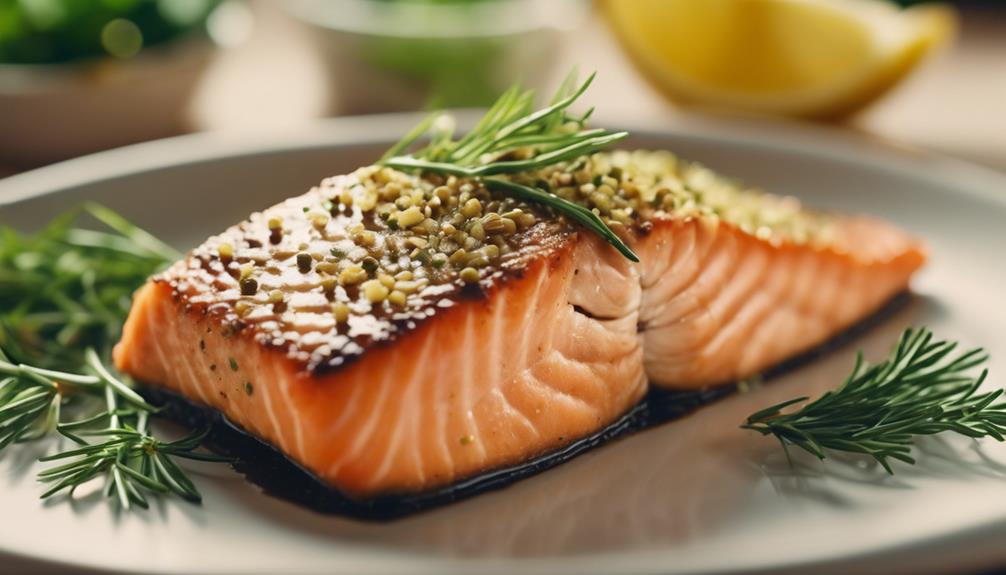
Achieve peak crispiness by preheating the oven to 425°F before baking the Pine Nut Crusted Salmon. To guarantee a perfectly crispy crust, start by patting dry the salmon fillets. This step is essential as excess moisture can prevent the crust from adhering properly. Next, firmly press the pine nut and breadcrumb mixture onto the salmon. The pressure helps the crust stick and form a delicious coating. For an extra golden-brown crust, sear the salmon in a hot pan before transferring it to the oven. This quick sear adds an extra layer of texture and flavor. Once baked, allow the salmon to rest for a few minutes before serving. This resting period helps maintain the crispy texture of the crust. Remember, a squeeze of fresh lemon juice just before serving can elevate the flavors and add a revitalizing zing to your Pine Nut Crusted Salmon.
| Tips for Perfectly Crispy Crust | |
|---|---|
| Preheat oven to 425°F | Pat dry salmon fillets |
| Press crust mixture firmly | Sear in hot pan |
| Allow salmon to rest | Add lemon juice |
Serving Suggestions for Salmon
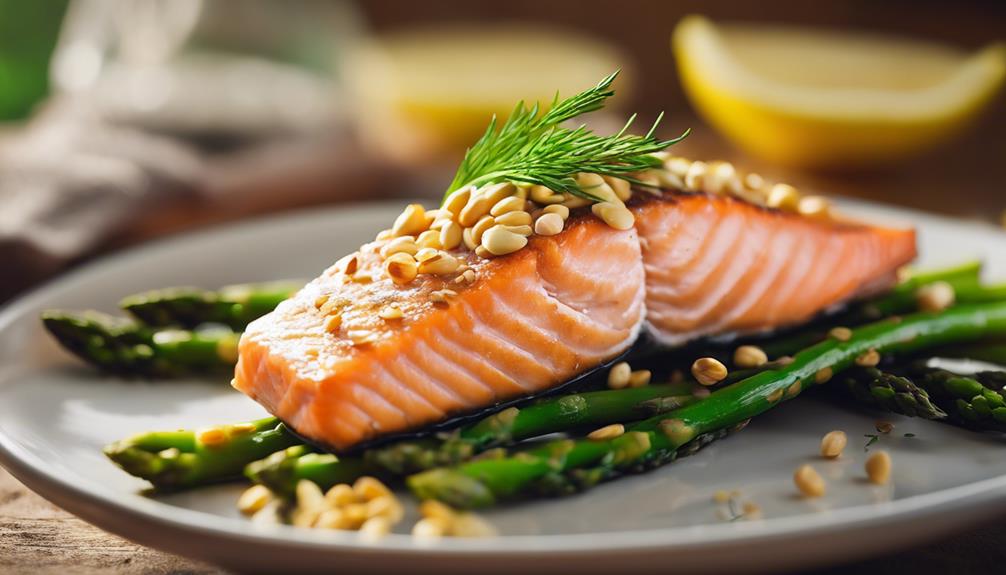
Enhance your dining experience by pairing your pine nut crusted salmon with complementary side dishes and garnishes. For a balanced meal, serve the salmon over a bed of quinoa or couscous, providing a hearty base that complements the rich flavors of the salmon.
Add a side of lemon-dressed arugula to bring a revitalizing and tangy contrast to the dish. Accompany your salmon with grilled asparagus or roasted vegetables to introduce vibrant colors and essential nutrients to your plate.
- Lemon-Dressed Arugula: Revitalizing and tangy, this side salad provides a perfect contrast to the rich flavors of the salmon.
- Quinoa or Couscous Bed: A hearty base that complements the pine nut crust while adding a satisfying element to the meal.
- Grilled Asparagus or Roasted Vegetables: Vibrant in color and rich in nutrients, these sides add both visual appeal and nutritional value to your salmon dish.
Wine Pairing Recommendations

Explore the ideal wine pairings to elevate your dining experience with pine nut crusted salmon. When choosing a wine to accompany this gourmet dish, consider the following recommendations for the perfect pairing:
| Wine Type | Flavor Profile and Characteristics |
|---|---|
| Chardonnay | Enhances buttery flavors, complements richness of the dish |
| Pinot Noir | Earthy notes, red fruit undertones match well with nutty flavors |
| Sauvignon Blanc | Crisp acidity balances richness, enhances overall flavors |
| Merlot | Subtle smokiness complements nut crust, adds depth to experience |
Each wine type brings a unique set of characteristics that can enhance different aspects of the pine nut crusted salmon. The Chardonnay's buttery notes can complement the richness of the dish, while a Pinot Noir's earthy undertones can harmonize with the nutty flavors. For a lighter option, a Sauvignon Blanc's crisp acidity can balance the richness, and a Merlot's smokiness can add depth to the dining experience. Choose your wine pairing wisely to elevate the flavors of your gourmet dinner.
Health Benefits of Eating Salmon
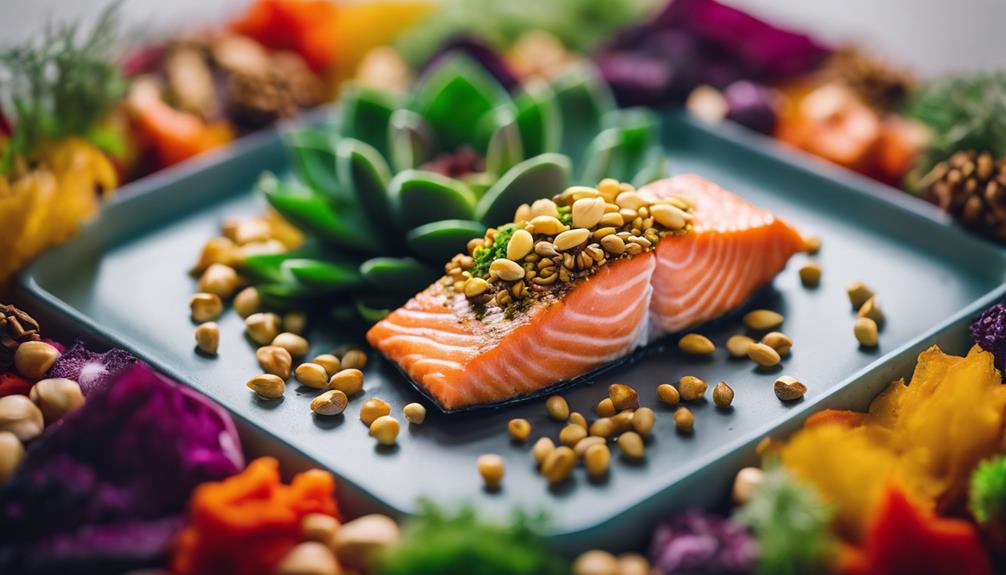
To boost your overall health and well-being, incorporating salmon into your diet can provide a wide array of benefits due to its rich nutritional profile. Salmon is a powerhouse of nutrients, particularly known for its high content of omega-3 fatty acids, essential for brain and heart health.
The omega-3 fatty acids in salmon not only support cognitive function but also help reduce inflammation in the body, which is essential for overall health. Additionally, salmon serves as a high-quality protein source, important for muscle repair and growth.
- Rich in Omega-3 Fatty Acids
- Reduces Inflammation
- Excellent Source of High-Quality Protein
In addition to these benefits, consuming salmon has been associated with a decreased risk of heart disease and stroke. This nutrient-dense fish also offers essential vitamins like D and B12, along with selenium, contributing to your overall health and well-being.
Incorporating salmon into your diet can be a smart choice for enhancing your nutritional intake and supporting various aspects of your health.
Storing Leftover Pine Nut Salmon
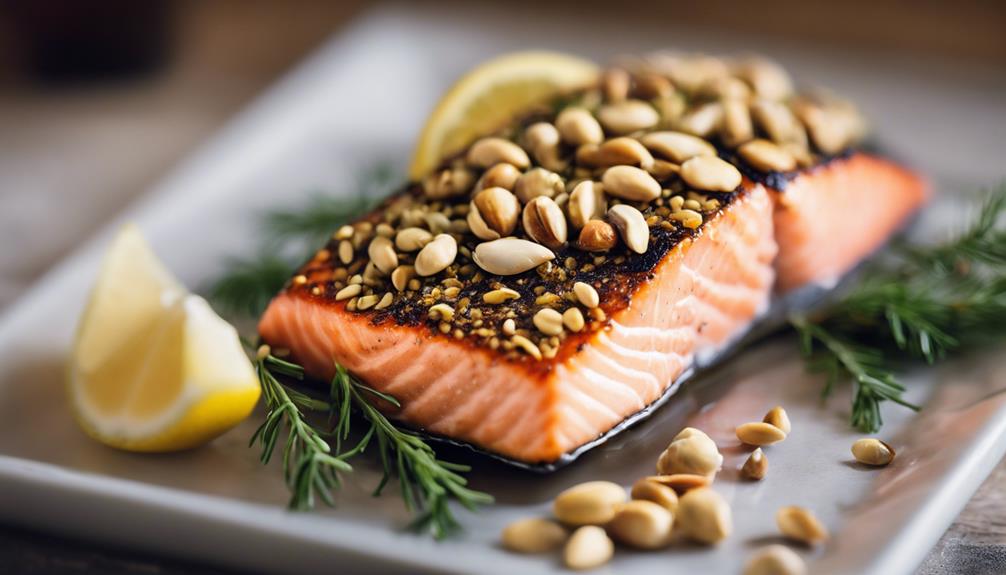
You can extend the shelf life of leftover pine nut crusted salmon by storing it in an airtight container in the refrigerator for up to 3-4 days.
To maintain the crispy texture of the pine nut crust, it's advisable to keep the salmon separate from any sauces or liquids.
When reheating the leftover pine nut salmon, using the oven instead of the microwave can help retain the crunchiness of the crust.
Consider enhancing the flavors of the dish by adding fresh toppings or a drizzle of lemon juice before reheating.
It's recommended to avoid freezing leftover pine nut crusted salmon, as the texture of the crust may become soggy upon thawing.
If you plan to store the salmon for a short period, transferring it to a mixing bowl and covering it tightly with plastic wrap can also help maintain its freshness.
Remember to consume the leftover pine nut salmon within the recommended timeframe to enjoy it at its best quality.
Frequently Asked Questions
What to Pair With Salmon for Dinner?
Looking to pair salmon for dinner? Consider roasted asparagus with balsamic glaze for an elegant touch. Citrusy quinoa salad with herbs and lemon brings a light vibe. Creamy dill sauce with garlic mashed potatoes offers comfort. Try a Greek salad for Mediterranean flavors.
What Is Salmon Usually Served With?
Salmon is often paired with side dishes like roasted veggies, quinoa, or a fresh salad to create a balanced meal. Common accompaniments include citrus sauces, mashed potatoes, and cucumber salad. Flavorful herbs like parsley, basil, and dill enhance the fish's taste.
What Goes Well With Smoked Salmon?
When serving smoked salmon, remember that it pairs beautifully with cream cheese on bagels, capers, red onion, and dill on a charcuterie board, salads with arugula and avocado, or in pasta dishes like fettuccine alfredo. Enjoy the flavors!
What Is the Best Sauce to Eat With Salmon?
When enjoying salmon, you can't go wrong with a lemon cream sauce for a tangy kick. Beurre blanc offers a rich, velvety experience. Try a light dill sauce with garlic for a herby touch. A white wine and caper sauce adds zesty flavors.
Can I Use Different Types of Nuts to Crust My Salmon?
Yes, you can absolutely use different types of nuts to crust your salmon. Almonds, pecans, and pistachios are all great options to create a unique and flavorful crust for your sesame crusted salmon recipe. Experimenting with different nuts can add delicious variations to your dish.
Conclusion
To sum up, pine nut crusted salmon offers a delectable gourmet dining experience with its crispy texture and rich flavor profile.
So, why not elevate your next dinner with this exquisite dish that's sure to impress your guests?
Don't miss out on the opportunity to indulge in a culinary masterpiece that combines the best of seafood and nuts.
Try it today and savor every bite of this delightful fusion of flavors!
